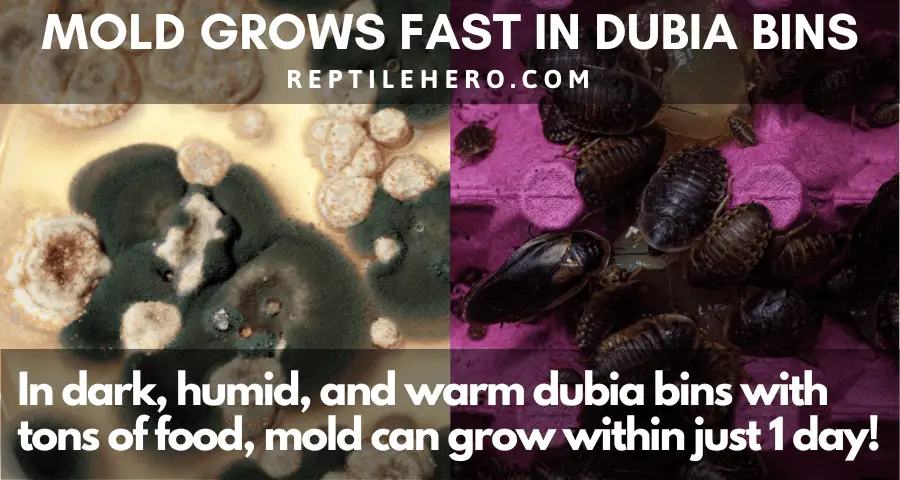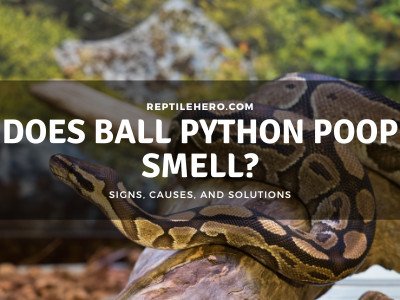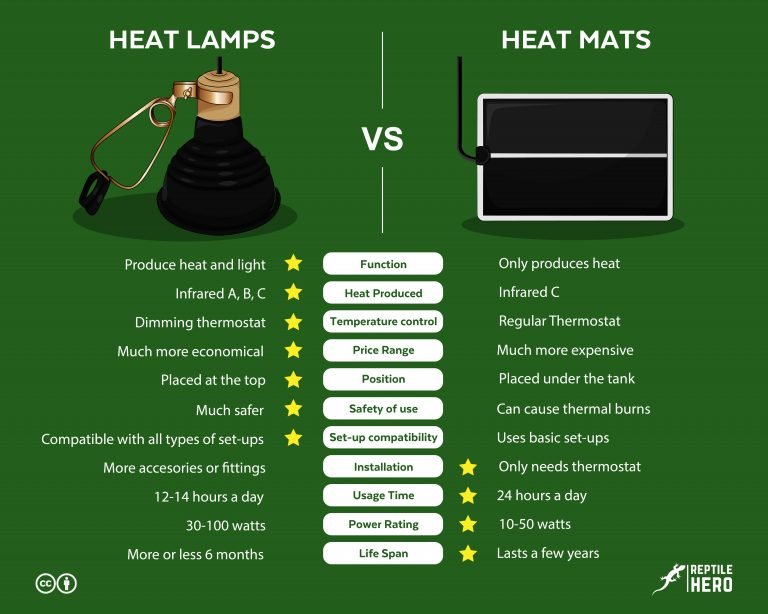Got Mold in Your Dubia Bin? Here are 5 Steps to Remove It!
Think you’ve got a mold problem in your dubia roach bin? Whether you’ve just set up your breeding bin or you’ve got a years-old well-established colony, it can indeed be worrying. Mold can kill off whole colonies of dubia if left untreated, so familiarize yourself with ways to prevent and address a moldy bin!
Mold developed in dubia roach bin can be removed by 1) collecting the roaches, 2) disposing of affected materials, 3) removing food and water, 4) cleaning the bin, and then 5) placing the dubias back into the newly disinfected bin. This should be done in an open area while wearing safety goggles, respirator masks, and surgical gloves.
When only a small part of the substrate has mold, can you just spot-clean the dubia bin? More importantly, can roaches expose to mold harm your leopard gecko? Find out the answers to these and more by scrolling until the end!
1. Collect the Dubia Roaches
Using sorting strainers, dubias must be collected from the moldy colony bin and temporarily transferred to an empty, clean, and smooth-walled bin. The cockroaches must be separated from all the frass and other contaminated bin materials.
Dubia roach bins affected by mold must be brought out to a well-ventilated area before opening them for cleaning. When possible, it’s best to do it out in the open like in the yard or garage.
This is important to avoid having the spores scatter around, which is also key in preventing future mold development.
Moreover, you should always wear safety gear—the goggles, mask, and gloves—beforehand. This will lessen the risks of irritation and allergic reactions you may get from not only the mold but the frass as well.
If you could, it’s also advisable to lay out a plastic tarp before opening up the moldy bin to help you contain the mess you’ll be making more easily.
2. Dispose of the Cartons and Substrate
Absorbent materials such as cartons and most dubia bin substrate choices must be disposed of entirely. Even when mold growth has only been seen in small portions, everything must be discarded and then replaced.
With your gloved-up hands, carefully inspect each item in the bin, especially the egg crates and substrate. Oats, specifically, seem to be prone to molding in dubia bins.
People who breed mealworms and other live feeders for their pet reptiles like geckos and snakes have observed this as well, which is why they typically aren’t recommended.
If you find any roach still clinging to the infected bin materials, you can either toss them or keep them. It’s your call. Dubia keepers and breeders have done both without much issue.

All materials used for raising dubia roaches should be bagged, sealed, and then frozen for about 3 days before disposal—regardless of whether or not they became moldy.
Regular mold-contaminated materials can typically be discarded as normal waste when tightly sealed in a plastic bag [1]. But the same cannot be said for materials used for dubia roach keeping and breeding.
Experts say that freezing is important to humanely kill off very small dubia nymphs and other tiny microorganisms that might have grown in the bin.
Otherwise, if they could get out of the bag, they could potentially disrupt and harm the local ecosystem. Remember, dubia cockroaches are not native to North America.
3. Remove Food and Water
Whether or not mold growth is visible on food items and water crystals inside a contaminated dubia colony bin, they must be disposed of completely.
It’s the same with moldy sliced bread, even if only one or two slices have visible mold growth, you should trash the entire loaf. This is because the mold spores have likely already spread to different parts of the food.
Sure, you could try to save the non-moldy food item and water crystals. But it’s going to be more troublesome in the long run. You’ll just waste time, money, and energy.
After you clean up the tub nicely, if you place the old food and water crystals from the moldy setup back inside without addressing the root cause of molding, the cycle will only repeat. You’re bound to experience mold problems again soon.
For disposal, place the leftover food and water crystals in a plastic bag, then seal and freeze it before finally taking it out along with your regular garbage bags for collection.
4. Clean the Entire Bin
Thoroughly clean the plastic bin used for the dubia roach colony by removing the mold with a damp cloth and then letting it dry completely. Ideally, the cloth should be soaked in either detergent or vinegar for proper disinfection.
I have good news—you don’t have to set up a new colony bin entirely from scratch! Not everything has to be brand new.
You just have to make sure to clean and disinfect all other salvageable items like the food bowls and the plastic storage bin itself.
The United States Environmental Protection Agency advises against the use of harsh chemicals like chlorine bleach for removing and cleaning the mold.
Honestly, I was surprised when I first found out that bleach may actually promote instead of prevent mold growth. This is because—as it turns out—bleach can only get rid of mold at the surface level [2].
So instead of using bleach, which is corrosive and highly irritating, it’s better to use a regular anti-bacterial detergent (here on Amazon) with water to clean off mold effectively.
Experts also recommend spraying distilled white vinegar directly on the mold. Let the vinegar sit on the mold-contaminated areas of the bin for at least 1 whole hour. After that, you can wipe it clean with a fresh rag that’s been soaked in water and then let it dry.
Oh, and don’t forget to clean the thermometer and hygrometer in the roach bin as well!
Remember to dispose of all the rags or brushes you used to clean off the mold as well. Otherwise, you may unknowingly be spreading the spores around if they have not been disinfected after use.
5. Place the Dubia in the Mold-Free Bin
Once the moldy dubia bin is properly disinfected, it can set it up once again with fresh food, clean water, as well as new cartons and/or substrate. Finally, the dubia roaches can be housed in a clean breeding bin.
Check if your set-up is correct in our article on breeding dubia roaches.
After you’ve cleaned and revived your once-moldy colony bin, the problem’s solved, right?
Technically, problems are solved by cleaning. But at the same time, they aren’t. Unless you can effectively prevent mold growth, you can’t totally deal with molds.
Moreover, you have to understand what mold is, how it develops, and its possible effects—which I will be discussing next!
Why Does Mold Grow in Dubia Roach Bins?
Mold grows in a dubia bin because it’s a humid, warm, dark, and enclosed space where they can feed on organic matter like cartons and frass.
So, to put it simply, dubias and molds typically thrive in similar environments. Contrary to popular belief, this also means that cockroaches are not necessarily attracted by mold.

Furthermore, mold doesn’t grow in isolation. According to scientists, microscopic mold spores are almost always present in the air. When the conditions are ideal, mold spores can cause visible growth within 1–2 days!
This is the main reason why experts recommend getting rid of mold-contaminated materials entirely if they cannot be cleaned thoroughly alongside different preventive measures.
What mold is growing in your dubia roach bins?
Unless sampled and tested, it is not possible to correctly identify mold growth of different colors in dubia roach bins. However, several mold isolates, including Aspergillus sp., Cladosporium sp., Penicillium sp., and Trichoderma sp., have been identified in some cockroaches.
11 Ways to Prevent Mold Development in Dubia Bins
In general, mold development in dubia bins can be effectively prevented by increasing light exposure, improving ventilation, decreasing humidity, lowering the temperature, and/or reducing organic matter.
As always, the best solution to any problem is prevention. In other words, rather than waiting for mold to develop, keepers should prevent mold from ever developing.
Below are great ways to prevent mold growth in dubia roach colony bins:
- Regularly clean the dubia colony bin.
- Create more and/or bigger ventilation holes.
- Maintain humidity within 40–60%.
- Replace uneaten dubia food every 2–3 days.
- Keep the food and water in their own bowls.
- Choose less water-rich food for dubia roaches.
- Use cork bark instead of egg crates.
- Change out oat substrate with non-food options.
- Get rid of the substrate completely.
- Add detritivores to a bin with a soil-based substrate.
- Set up a bioactive enclosure for dubias.
All of these tricks can be done together with great success. But you can also try out one thing at a time to see which works better for you since we all have different circumstances.
Discover other tips in our article on moldy gecko eggs!
Will Dubia Roaches Die Because of Mold?
Many dubia breeders and keepers have reported losing a good portion of or an entire colony after being unable to address mold issues immediately.
Mold is known to cause allergic reactions and respiratory, skin, and eye infections in humans. However, toxic reactions to mold are still not widely studied.
So it goes without saying that mold’s effects on cockroaches who are often found in direct contact are not well-understood.
We should also keep in mind that there are different types of molds. Some are relatively harmless, while others may be quite toxic and trigger acute or chronic symptoms with varying degrees of severity.
Further Questions
Do dubia roaches eat mold?
Although many people believe that cockroaches eat mold, there is no evidence for this. This conclusion is generally made as other common species like the American cockroach are seen taking shelter in spaces where there is mold development.
Can you feed leopard geckos with dubia roaches from moldy bins?
Dubia roaches from moldy bins can still be fed off to leopard geckos after their container has been cleaned and revived. However, it’s recommended to not disturb the resettled dubia roaches for 1–4 weeks and allow them to eat fresh food and drink clean water before feeding them to insectivorous pets to ensure that they are safe to eat.
Do moldy dubia roach bins smell bad?
Moldy dubia roach bins typically smell really bad because mold can produce release volatile organic compounds or VOCs that often have strong unpleasant odors. The smell may become even worse when there is a significant amount of spoiled food left in the already moldy bin.
Can dubias transmit diseases?
Like many other insects and cockroach species, dubia roaches can also carry a multitude of different disease-causing bacteria and viruses for varying durations and distances. But there have yet to be reports of dubias directly transmitting diseases to leopard geckos and other reptiles.
Do you need to dust dubia roaches before feeding them to geckos?
Dust dubia roaches with calcium powder and other supplements as recommended by a veterinarian to prevent metabolic bone disease and other diet-related illnesses in geckos. This is preferable to having dubias directly feed on calcium which can make their exoskeleton harder, making them harder to eat and digest.
Summary of Mold in Your Dubia Bin
Dubia roaches from a moldy breeding bin can still be saved and fed off to geckos and other insect-eating pets. However, the molding must first be addressed and further development must be prevented so that the problem doesn’t repeat itself.
Proper safety gear must be worn while cleaning the mold-contaminated bin in an open area. The dubias must be separated and housed temporarily in another plastic bin. All biodegradable items like the carton and food must be bagged, frozen, and disposed of, whereas plastics like food bowls and the bin itself can be reused after disinfection.
After the mold has been successfully removed from the bin, it can once again be set up to ensure the optimal growth and breeding of dubia roaches. However, keepers must take note of humidity, temperature, light, ventilation, and biodegradables to avoid more mold issues.

![3 Reasons Why Your Gecko Smells Bad [and 7 Tips]](https://www.reptilehero.com/wp-content/uploads/2021/04/G34_2-1-768x614.jpg)

![Why Does Your Gecko Lick? [You, Themselves, and Other Objects]](https://www.reptilehero.com/wp-content/uploads/2021/05/gecko-lick-object-cc-768x614.jpg)


